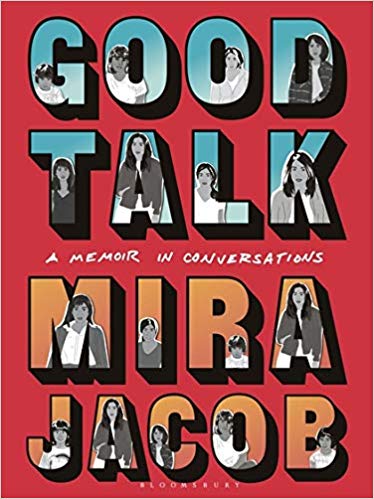Mira Jacob’s “Good Talk”

Award-winning author Mira Jacob‘s Good Talk is a graphic memoir. It was written after the extraordinary success of her 37 Difficult Questions From My Mixed-Race Son: “Are white people afraid of brown people?” published on BuzzFeed ( 8 June 2015). Though seemingly inspired by the questions her son posed to her incessantly about Michael Jackson, music and race but the Good Talk is also much more. It is much more than the conversations every sane and rational parent has with their children, let alone those of mixed parentage. It is all about the difficult conversations that are most often ignored even by adults. These are mostly revolving around race in America.
Mira Jacob’s Syrian Christian parents immigrated to America in 1968. So Mira and her brother were born and brought up in America and are Americans. Yet because of their brown skin colour the Jacob children have experienced racism at all levels whether as microaggression or explicity racist comments/attacks as the horrific one described in Good Talk of Mira Jacob being physically assaulted in public. This is quite unlike the America Mira Jacob’s Jewish husband, Jed Rothstein, has ever had to face as he is white.
To unpack all that exists in this exquisite graphic memoir will take an essay longer than the book itself! There is much to read, analyse, mull over and share. Many, many readers will have the same reaction that they did to Mira Jacob’s first book The Sleepwalker’s Guide to Dancing — “This is a story about us and our family.” It is immaterial that Good Talk has been written by an American of East Indian / South Asian origin. This is a book that will resonate with readers of different nationalities. A fact Mira Jacob records in “I Gave A Speech About Race To The Publishing Industry And No One Heard Me” about the reaction of readers to her first novel.
…really, it happened a lot. It happened with people of all ages, races, and genders. It happened at readings and it happened in emails and a lot of times it was just a thank you for writing this book — but just as often, it was someone commenting on the family dynamics. “I know you are Indian,” they would say, “but really, this is about my family, the Italians. My family, the Jews. My family, the Greeks. The Dominicans. The Koreans. The Irish.”
In a fabulous interview on Longreads, Mira Jacob speaks of the title, particularly within the context of parenting in this new world. ( “Imagine Us, Because We’re Here: An interview with Mira Jacob, March 2019)
The title is really tongue in cheek because so many of the talks in here are not anything you would ever call a good talk. For me, it’s almost like when you step away from a conversation that you know has gone bafflingly off-the-rails and you’re like, ‘good talk, good talk’ you know? You just say it to yourself in this way that’s like, ‘that was a disaster, I don’t know how anyone is going to recover from that one!’ Mostly I would leave conversations with him and I would be like, ‘that’s another five years of therapy right there.’
This is the really frustrating thing about being a parent especially in this moment, but I imagine all parents in every moment feel this — that despite all your carefully laid ideas about how you’re going to grow a small human into a big one, it’s just a disaster. It’s a shitshow left and right. You’re doing your very very best and it is so not even close to enough.
Good Talk must be read by everyone. This is not a memoir meant only for adults. Share it widely.
10 June 2019

